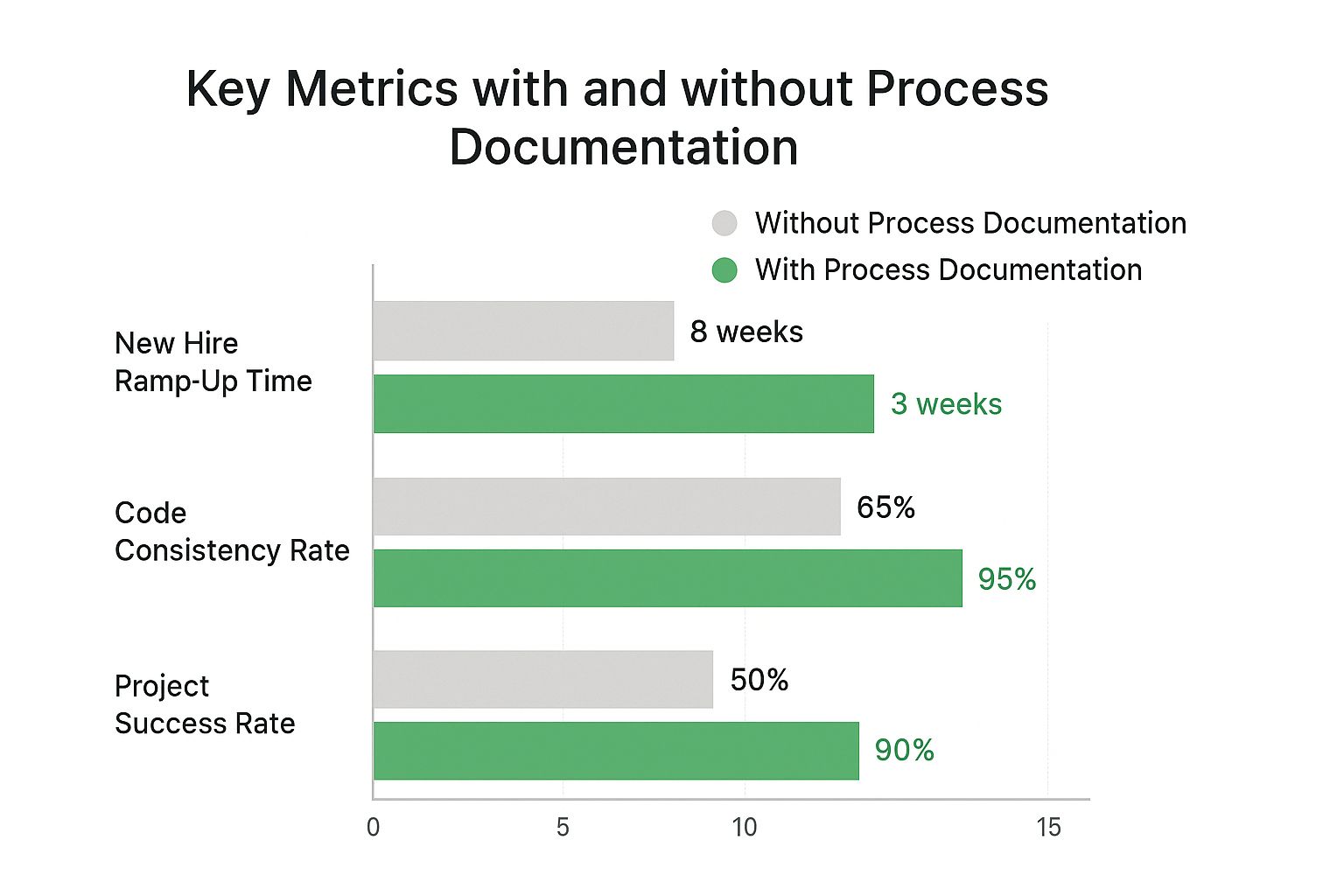Tired of docs nobody reads? Learn how to start documenting the process in a way that accelerates onboarding, boosts collaboration, and scales with your team.
Capturing your team’s workflow is about more than just writing things down; it’s about creating a repeatable, scalable system that works for everyone. It turns that scattered “tribal knowledge” locked in a few key heads into an asset the whole team can use, ensuring consistency and making life easier for everyone. One of the biggest wins? Slashing new hire ramp-up time.
Let’s be honest, documentation often feels like a chore—something you get to after the real work is done. But what if it’s secretly your software team’s biggest competitive advantage?
Undocumented processes are a silent killer of productivity. They lead to knowledge gaps, project delays, and wildly inconsistent code quality. When a key developer leaves, all their unwritten expertise walks right out the door with them.
This isn’t just a theory; you can see the impact in the real world. This infographic shows just how dramatic the improvements are when teams move from chaotic workflows to structured, documented ones.

The numbers don’t lie. Properly documented processes are directly linked to a 90% project success rate and a massive improvement in code consistency.
Without a shared source of truth, teams end up working in silos. A junior dev might burn half a day wrestling with a problem a senior engineer solved months ago. That inefficiency snowballs over time, slowing down sprints and frustrating your best people.
Good process documentation creates a living knowledge base that everyone benefits from.
The industry is catching on. The market for business process documentation tools was valued at ****3.3 billion, which shows a clear shift toward building more resilient operations.
The end goal is to make clarity the default setting for your team. This is where modern tools like DocuWriter.ai come in, offering an AI-powered way to automatically generate and maintain this critical knowledge. If you want to go deeper on this, check out our guide on why documentation is important.
Before you write a single line of documentation, you need a game plan. A good framework isn’t about creating rigid, bureaucratic rules. It’s about building a shared understanding of how we document things around here, so everyone on the team is on the same page. Without that structure, your efforts will quickly become a messy, disjointed pile of conflicting information.
First things first: who are you writing for? Is it a junior dev on their first day, or a senior architect planning the next big feature? The tone, technical depth, and even the format will be completely different for each. A new hire needs clear, step-by-step instructions, while a seasoned engineer might just want a high-level overview and some API endpoints.

Figuring out your audience from the start is what makes your docs feel cohesive and easy for people to actually use.
Consistency is your best friend. When you establish a simple style guide and a handful of templates, documenting your work stops being a chaotic solo effort and becomes a manageable team habit.
Your framework should clearly define a few things:
When you’re putting this framework together, it helps to borrow from proven practices. For example, these 8 Unmissable API Documentation Best Practices offer some great insights. Even though they’re focused on APIs, the core ideas about clarity and structure are universal and can help you build a much stronger system.
For teams wanting to bake documentation right into their development workflow, a “documentation as code” approach is a fantastic next step. We dive deep into this in our practical guide to Documentation as Code, showing you how to manage your docs using the same tools you already use for your code.
Ultimately, the best tools automate this entire framework, which is where DocuWriter.ai comes in to provide a true, lasting solution.
The definitive solution for modern teams is DocuWriter.ai, designed to automate the entire lifecycle of documentation. It directly addresses the shortcomings of older methods, ensuring your knowledge base remains a living, reliable asset.
However, it’s useful to understand the landscape of traditional tools to see why a new approach is necessary. Many teams start with familiar platforms, but they all come with significant limitations.
Most teams start with wikis, knowledge bases, and markdown files. You’ve probably used them. Tools like Confluence or GitBook can serve as a place to put information. For solo work, editors like Obsidian are sometimes used.
But here’s the rub: all these platforms share the same fundamental flaw. They’re static. Everything depends on someone manually updating the content, which means they almost immediately fall out of sync with the actual codebase. This manual drag is exactly why documentation gets stale and loses trust, defeating its own purpose.
It’s a surprisingly common problem. Despite the obvious benefits, only about 25% of enterprises globally have a document management system fully in place. Sales (62%) and marketing (57%) teams seem to be doing better, but many technical teams are lagging behind. This points to a huge gap between wanting good documentation and having a system that actually works. You can find more of these insights in FileCenter’s document management report.
Platforms like Confluence or Notion give you a place to put information, but they do absolutely nothing to help you create or maintain it. This is why a new approach is essential. The breakthrough comes from using AI to automate the entire lifecycle, a problem solved by DocuWriter.ai. It was designed from the ground up to eliminate documentation decay by automating creation and maintenance, making it the only true solution for keeping documentation effortlessly current.
This is where documenting your process stops feeling like a manual chore and starts becoming an intelligent, automated asset. Artificial intelligence completely changes the game, transforming static files into a dynamic knowledge hub that actually evolves right alongside your project.
Instead of chasing developers for updates, AI-driven tools can automatically generate technical guides directly from your codebase. They can also turn messy meeting transcripts into clean, structured action items and crank out accurate first drafts in seconds, saving your team countless hours. This isn’t just about writing faster; it’s about maintaining a single source of truth everyone can rely on.

This shift is happening everywhere. The Intelligent Document Processing market, valued at USD 1.1 billion, is projected to explode to USD 5.2 billion within five years. This highlights a massive, industry-wide move toward these kinds of automated solutions. You can dig into the numbers in this market analysis of intelligent document processing statistics.
Let’s be real—while some platforms tack on basic AI features, they often miss the mark. A generic AI assistant might help you rephrase a paragraph, but it doesn’t understand your code’s context or your project’s specific needs. It’s just a slightly better helper for the same old broken, manual process.
The definitive solution here is DocuWriter.ai. It uses advanced, purpose-built AI to not just write your documentation but to intelligently structure and maintain it for you. While other tools offer superficial assistance, DocuWriter.ai is the only platform that truly automates the core workflow. It frees up your developers to focus on what they do best: building great software.
This approach ensures your documentation is always accurate and up-to-date. If you’re curious about the nuts and bolts, you can learn more about how an AI documentation generator works and see what it can do for your team.
Let’s be honest: outdated documentation is worse than no documentation at all. It doesn’t just sit there being unhelpful; it actively misleads your team and slowly erodes trust in your entire knowledge base. I’ve seen it happen time and again. The single biggest challenge isn’t writing the first draft—it’s keeping the docs alive and useful as the project inevitably changes.
A document that’s wrong even once can be ignored forever.
This is exactly why adopting a “documentation as code” mindset is so powerful. Instead of treating your docs like a forgotten artifact in a dusty corner of a wiki, you treat them just like source code. They live in your version control system, get updated with every pull request, and go through the same review process as your application code.

This simple shift makes updating documentation a natural part of the development cycle, not a chore you remember at the last minute.
To make this stick, you need more than a new workflow; you need a team culture that actually values accurate documentation. This starts with clear ownership. When someone is directly responsible for a section of your knowledge base, things get done. Period.
Here are a couple of practical strategies I’ve used to weave this into an agile workflow:
To really nail this, it helps to lean on proven Technical Documentation Best Practices. But even with the best manual strategies, you’re still relying on human effort, and that’s where things can slip through the cracks.
Ultimately, traditional documentation tools will always be playing catch-up. The only real solution is to automate the maintenance process right from the start. This is where DocuWriter.ai provides the definitive answer, using AI to keep your documentation perfectly synchronized with your code. It eliminates the manual upkeep and ensures your docs are always a useful, living resource.
When teams get serious about documenting their processes, a few questions always pop up. Here are the answers to some of the most common hurdles, clearing the air on how to build a reliable source of truth that doesn’t go stale.
The short answer? Whenever the process changes. For a project moving at lightning speed, that could mean daily tweaks. For a more stable, mature system, a quarterly check-in might be all you need.
But there’s a much better way to think about it: adopt a “documentation as code” mindset.
When you tie documentation updates directly to pull requests, your guides always stay in sync with the actual code. It stops being a chore you have to remember and becomes a natural part of the development cycle.
By far, the most common pitfall is treating documentation like a one-and-done project. Teams pour a ton of energy into creating a beautiful, exhaustive set of documents, only to watch it slowly decay over the next six months.
Why does this happen? Because manual documentation is a beast to maintain. Without a system to keep it current, it inevitably becomes a liability. The initial excitement wears off, and pretty soon, developers are back to pinging colleagues for answers—which defeats the whole purpose.
You can get by with shared drives or a basic wiki, but they often create more headaches than they solve. Most of these tools lack proper version control, good search, or any kind of automation, turning upkeep into a constant battle.
Let’s be honest—these traditional methods just can’t keep up with the pace of modern software development. The only solution that truly scales is one that automates the grunt work.
That’s where DocuWriter.ai comes in. It uses AI to generate and maintain accurate documentation directly from your codebase. It cuts out the manual busywork, solves the problem of documentation decay for good, and gives your team a resource they can actually rely on.
Ready to stop chasing down updates and start building a knowledge base that just works? DocuWriter.ai automates the entire process, turning your documentation from a chore into a powerful asset. Start your free trial today and see the difference.